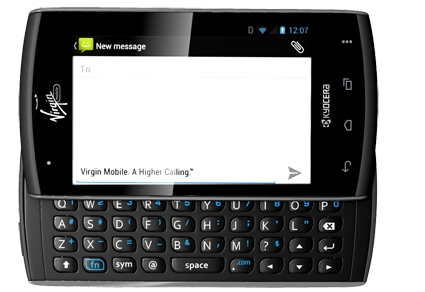Let’s be blunt, Kyocera doesn’t have the best reputation as a cellphone maker. Known for making budget phones that feel cheap in the hand, with dated operating systems and limited features, Kyocera is hardly any Techcitement writer’s “go to” company. In fact, we generally consider those phones to be barely a step up from feature phones.
The Kyocera Rise, however, caught our attention despite this bad reputation. For starters, it’s a rarity in that the Rise was released for both Sprint and for Sprint’s no-contract Virgin line at almost the same time. On Sprint, you can get the Rise for free; on Virgin, it will cost you $99. Clearly, this does nothing to assuage the budget rep, but at least initial pricing is reasonable. The other thing that caught our eye was the slider keyboard. Physical keyboards are a deciding factor for many and something that can be implemented brilliantly or poorly. The last two Virgin Mobile phones that we reviewed, the Venture and the Optimus Slider absolutely bombed. Would the Rise manage to get a handle on that? We didn’t have to wonder that long, because Virgin Mobile sent one our way.
First Impressions
The Rise came in typical, no frills Virgin packaging. I get the branding thing, but it really would be nice to see them shake it up just a tad. Opening the blister pack revealed a phone that was, frankly, dull looking. Oddly, the uninspired styling almost makes the Rise stand out in an era of industrial design. There’s something retro about the grey, block-y physique.

Not sure if there’s enough branding on this.
As you can see, the front face sports two large logos, a massive bezel, and four capacitive buttons: back, home, switch apps, and menu. The right side has a dedicated camera button, while the left has the microUSB port and volume rocker. The top of the unit is graced with a headphone jack and the power button.
Physically, the Rise feels a bit like a toy. The phone’s slick plastic barely avoids being cheap. If you can make it out in the above photo, the screen is a fingerprint magnet.
Internally, the Rise sports a Qualcomm MSM8655 1.0 GHz processor with a laughable two GB of built-in storage and a microSD slot. The 1500 mAh battery sounds pitiful, but is surprisingly enough to get about six hours of talk time off of the 3G-only Rise. As for the camera — hell, it’s too depressing, so I’ll get back to it later.
My first impressions of the Rise can be summed up like this: I might pick up a demo unit, but only to put it right back down.
The Software/User Interface
In what is a fairly pleasant surprise, Kyocera loaded a totally unskinned version of Android 4.0 (Ice Cream Sandwich) on the Rise. Being able to run pure Android is a nice feature for me, as my hate for TouchWiz is well documented at this point. However, I want to add the caveat that I doubt Kyocera will update this phone to 4.1 (Jelly Bean) any time soon.
Despite the Rise having a processor much slower than what I usually use, Android actually performs fairly well. The lack of any flashy skin probably helps it along, but I found the phone to be responsive and snappy.
The most important user interface feature here though, is the keyboard, which I get into more in the Performance section.
Virgin throws on an ICE (In Case of Emergency) app, the usual two Virgin apps, and Sprint ID. That’s very light, and nice to see. Kyocera also adds one more feature: an “Eco Mode” to save power when the battery gets low. This slows the phone down just a bit, in my experience.


Comments are closed.